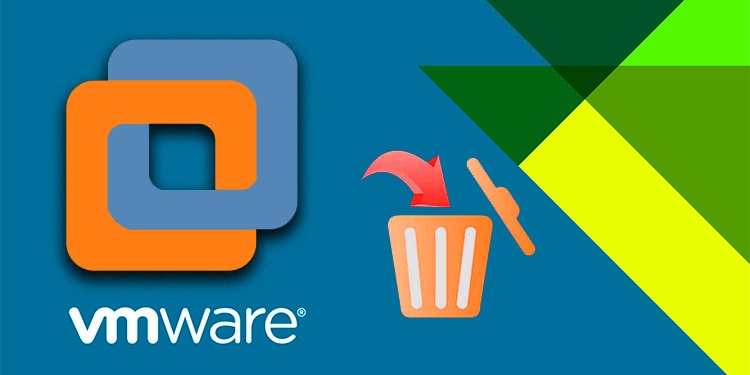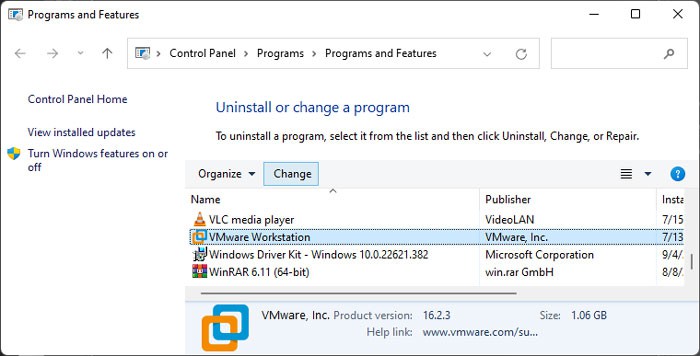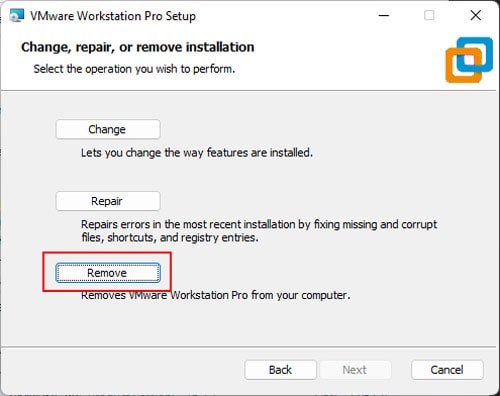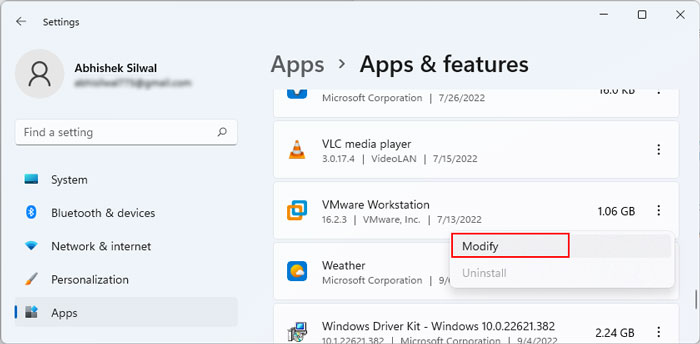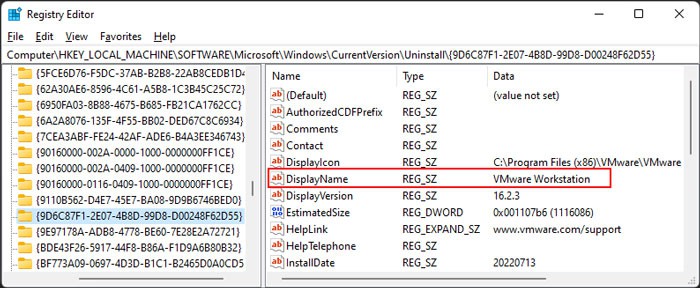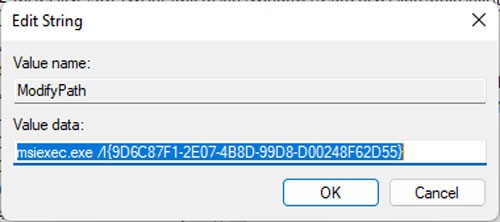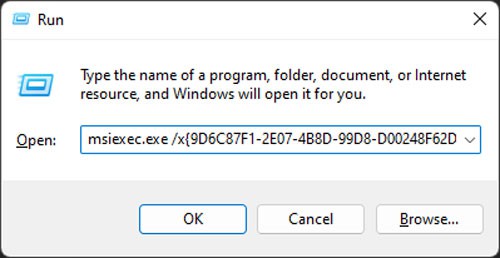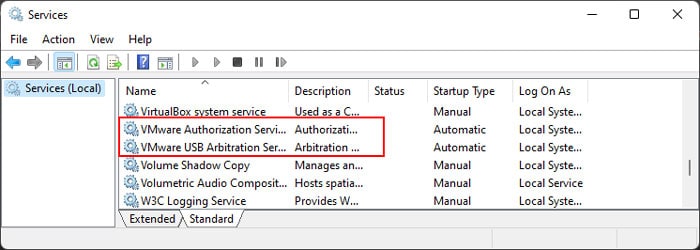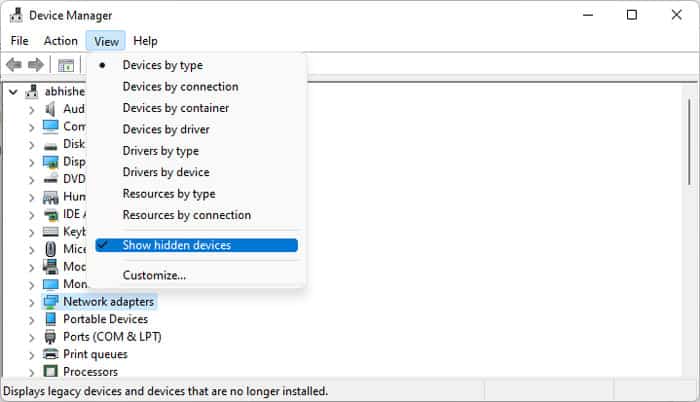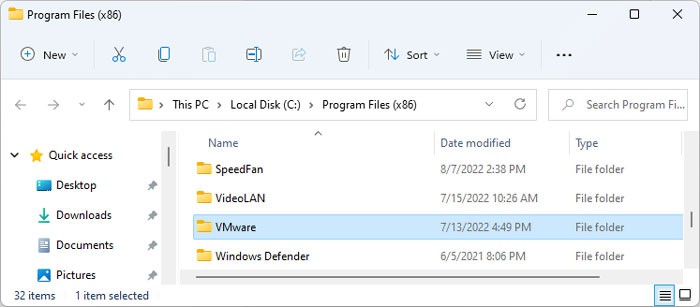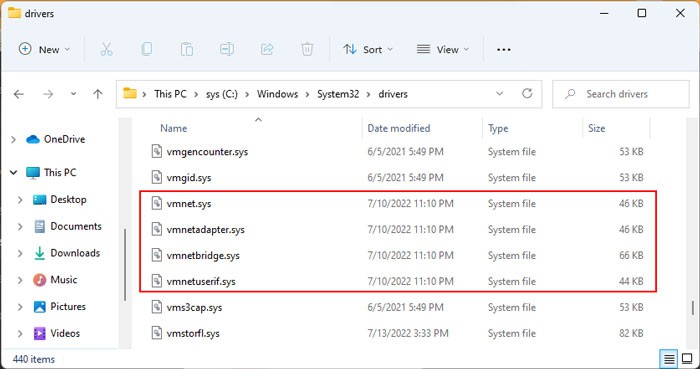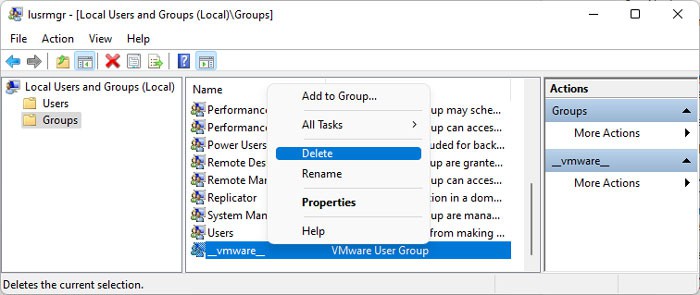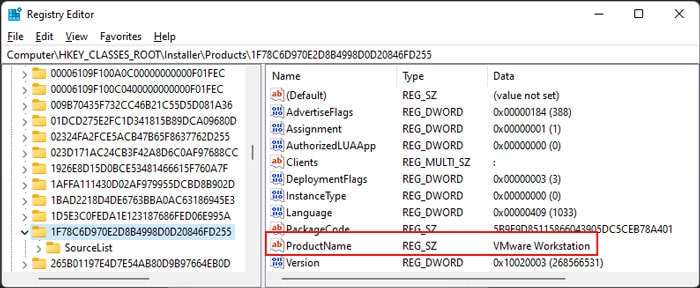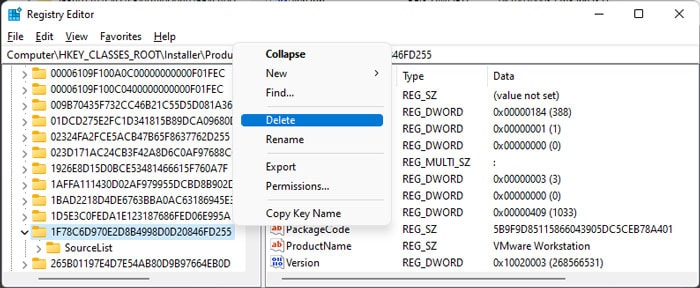- Ubuntu — Удалить VMWare Player и VMWare Workstation с помощью vmware-installer
- How to Uninstall VMware Workstation in Windows and Linux
- Uninstalling VMware on Windows
- Using Control Panel
- Through App Settings
- With Windows PowerShell
- Directly Using the Uninstaller/Modify Script
- Manually Remove VMware Files
- Uninstalling VMware on Linux
- Using the Uninstaller
- Manually Uninstalling VMware
Ubuntu — Удалить VMWare Player и VMWare Workstation с помощью vmware-installer
VMWare Workstation не поставляется с deb, не зарегистрирована в системе управления пакетами dpkg, ее не найти в менеджере приложений.
VMWare Workstation имеет собственную утилиту для установки и удаления.
Для вывода всех доступных вариантов введите:
$ vmware-installer Usage: vmware-installer [options] VMware Installer Options: --version show program's version number and exit -h, --help show this help message and exit Manage: Install or uninstall products -i FILE, --install-bundle=FILE Install bundle from FILE --install-component=FILE Install a component --uninstall-component=NAME Force uninstallation of a component -u NAME, --uninstall-product=NAME Uninstall a product -r, --resolve-system Force the system to resolve the current state --register-file=COMPONENT_NAME (config|regular) FILE Register a file in the database -x DIR, --extract=DIR Extract the contents of the bundle into DIR -p DIR, --prefix=DIR Set a custom install location Information: Look up information on installed products -l, --list-products List installed products -t, --list-components List the installed components -L COMPONENT, --list-files=COMPONENT List files for a given component -S FILE, --find-file=FILE List components and files matching the given pattern Settings: Set and retrieve settings -g COMPONENT KEY, --get-setting=COMPONENT KEY Get setting -s COMPONENT KEY VALUE, --set-setting=COMPONENT KEY VALUE Set setting -d COMPONENT KEY, --delete-setting=COMPONENT KEY Delete setting Options: --gtk Use the Gtk+ UI (Default) --console Use the console UI --custom Allow customization of the install, including file locations. --regular Displays questions that have no good defaults (Default) --required Displays only questions absolutely required -I, --ignore-errors Ignore component script errors --eulas-agreed Agree to the EULA Для вывода списка установленных VMWare продуктов добавьте ключ -l
$ vmware-installer -l Product Name Product Version ==================== ==================== vmware-player 15.0.2.10952284 Чтобы удалить VMWare Workstation, нужно запустить:
$ sudo vmware-installer --uninstall-product vmware-workstation Аналогично, чтобы удалить VMWare Player:
$ sudo vmware-installer --uninstall-product vmware-player How to Uninstall VMware Workstation in Windows and Linux
If you no longer need VMware, you might as well uninstall it to free up the space it takes. Additionally, you may need to uninstall it if you encounter any issues while using the app.
This process is very quick to perform. However, due to issues like power failure or conflicts from other applications, such as antivirus, you may not be able to uninstall the VMware.
Uninstalling VMware on Windows
The installation folder of older VMware versions included an uninstall.exe file that you could run to uninstall it. However, for the latest versions, you need to use the app settings or programs and features. You can also use a PowerShell cmdlet to uninstall this application.
If you can’t completely uninstall the program using these methods, you need to manually remove all its files and registry entries.
Using Control Panel
The traditional way of uninstalling an application is through the Programs and Features tool included in the Control Panel. Here’s how you can use it to uninstall VMware:
- Open Run by pressing Win + R.
- Type appwiz.cpl and press Enter to open the Control Panel’s Programs and Features page.
- Search for and select VMware Workstation or VMware Player and click on Change.
- Select Next and then Remove.
- Check the option you need to save and click Next.
Through App Settings
Windows 8 introduced the Settings app as an alternative for the Control Panel. You can use its App Settings to uninstall VMware on Windows 10 and later versions. To do so,
- Open Run.
- Enter ms-settings:appsfeatures to open the App Settings.
- Scroll down and search for VMware workstation or VMware Player.
- Select on it or click on the triple-dot icon next to it and choose Modify. You will be able to select Uninstall on older versions.
- Select Next and then Remove.
- Check the option you need to save and click Next.
With Windows PowerShell
You can also use the Uninstall-Package PowerShell cmdlet to uninstall your apps. Here’s how you can use it to remove VMware:
- Open Run.
- Type powershell and press Ctrl + Shift + Enter to open the Elevated Windows PowerShell.
- Enter the following command:
Get-Package -Name «VMware Workstation*» | Uninstall-Package
Replace Workstation with Player if you want to remove this app instead. - Type Y and press Enter if prompted.
Directly Using the Uninstaller/Modify Script
It is also possible to directly run a shortcut for the uninstaller wizard for VMware. First, you need to figure out what the script is through the Registry Editor and then run it. Here are the necessary steps for the complete process:
- Open Run and enter regedit to open the Registry Editor.
- Navigate to Computer\HKEY_LOCAL_MACHINE\SOFTWARE\Microsoft\Windows\CurrentVersion\Uninstall\
- This key is for VMware Workstation 16.x. Other versions may use a separate key. To get there,
- Go to Computer\HKEY_LOCAL_MACHINE\SOFTWARE\Microsoft\Windows\CurrentVersion\Uninstall\
- Select each key inside Uninstall and check the value of the DisplayName entry. It should show VMware Workstation or VMware Player.
- Double-click on ModifyPath and copy its Value data. For older versions, you need to copy the value of UninstallString.
- Open Run and paste the ModifyPath value.
- Replace /l with /x, then press Enter. For example, if the script in ModifyPath is msiexec.exe /l , you need to enter msiexec.exe /x
- Confirm your choice and follow the onscreen instructions.
Manually Remove VMware Files
If the above uninstallation processes fail, you won’t be able to uninstall the application properly. Then, you also can’t install VMware again on your system due to the persisting files.
In such cases, you need to manually remove the VMware files to clean up the incomplete uninstallation and properly remove the app from your PC.
First, log in with an administrator account and temporarily disable your antivirus and firewall. Then, follow the steps below one by one to manually remove VMware from your system:
Stop VMware Services
- Open Run and enter services.msc to open Services app.
- Search for all services starting with VMware.
Uninstall VMware Devices
- Open Run and enter devmgmt.msc to open the Device Manager.
- Select View >Show hidden devices.
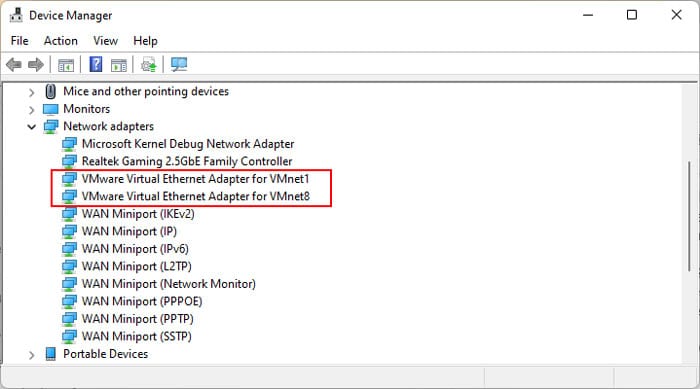
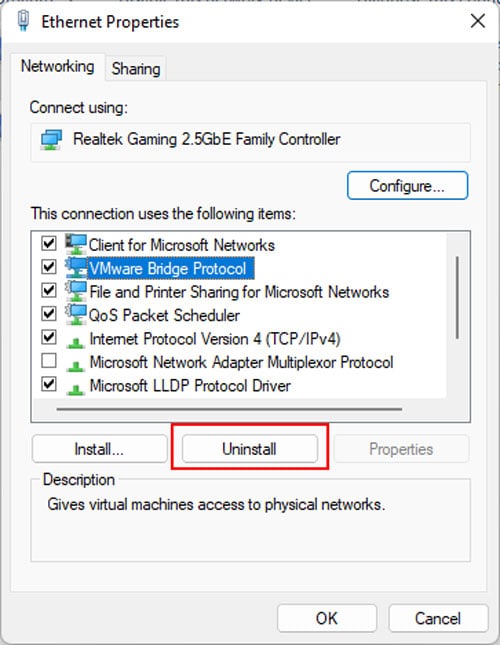
Delete VMware Folders and Files
- Press Win + E to open File Explorer.
- Navigate to C:\Program Files\ or C:\Program Files(X86)\ and delete the folder VMware.
- vmnat.exe
- vmnetbridge.exe
- VMNetDHCP.exe
- vmnetdhcp.leases
- vmxw2ksetup.dll
- vnetprobe.exe
- vnetprobelib.dll
- vnetinst.dll
- vnetlib.dll
- vnetlib.exe
- vmnet.sys
- vmnetx.sys
- VMparport.sys
- vmx86.sys
- vmnetadapter.sys
- vmnetbridge.sys
- vmnetuserif.sys
- hcmon.sys
- vmusb.sys
Delete VMware Users and Groups
- Open Run and enter lusrmgr.msc to open Local Users and Groups Manager.
- Double-click on Users and look for __vmware_user__.
- If it’s there, right-click on it and select Delete >Yes.
- Then, go to Groups and look for __vmware__.
- Use a similar way to delete it as well.
Delete VMware Registries
- Open the Registry Editor
- Navigate to Computer\HKEY_CLASSES_ROOT\Installer\Products\ and select the first key within Products.
- Check its Product Name.
- If it’s not VMware Workstation or Player, press the down arrow key to check for the next key inside Products.
- Use steps 3 and 4 to find out the key for VMware and note it down. The key is the folder inside Products.
- Right-click on this key and select Delete >Yes to remove it.
- HKEY_LOCAL_MACHINE\SOFTWARE\Classes\Installer\Features\
- HKEY_LOCAL_MACHINE\SOFTWARE\Classes\Installer\Products\
- HKEY_LOCAL_MACHINE\SOFTWARE\Microsoft\Windows\CurrentVersion\Installer\UserData\S-1-5-18\Products\
- HKEY_CLASSES_ROOT\Installer\UpgradeCodes\3F935F414A4C79542AD9C8D157A3CC39
- HKEY_LOCAL_MACHINE\SOFTWARE\Wow6432Node\VMware, Inc.\VMware Workstation
- HKEY_LOCAL_MACHINE\SOFTWARE\Classes\Applications\vmware.exe
- HKEY_LOCAL_MACHINE\SOFTWARE\VMware, Inc.
Uninstalling VMware on Linux
On a Command line-based system like Linux, you can easily use some commands to uninstall VMware on your computer.
Here, we use the commands for the Ubuntu Linux system. Other distros use different commands, so you need to search for and use those accordingly.
Using the Uninstaller
The default way of uninstalling VMware on Linux is by using the uninstaller script. Here’s how you can do so:
- Open the Terminal.
- Enter the following command depending on whether you want to remove VMware Workstation or VMware Player:
- sudo vmware-installer -u vmware-player
- sudo vmware-installer -u vmware-workstation
- You may also need to use the full path for vmware-installer, i.e., /usr/bin/vmware-installer
Manually Uninstalling VMware
If uninstalling VMware using the uninstaller fails, you need to manually remove all of its files. To do so,
- Open the Terminal.
- Enter the command below to stop VMware services and processes:
/etc/init.d/vmware stop - Move the VMware libraries to /tmp using the commands:
- uname -r (to check the kernel version)
- cd /lib/modules//misc (replace with your kernel version)
- mv vm* /tmp
- Then, you need to unload the kernel modules,
- rmmod vmnet.o
- rmmod vmmon.o
- rmmod vmci.o
- rmmod vmblock.o
- rmmod vmppuser.o
- Now, remove the VMware logon scripts using the commands:
- rm /etc/rc2.d/*vmware*
- rm /etc/rc3.d/*vmware*
- rm /etc/rc5.d/*vmware*
- rm /etc/rc6.d/*vmware*
- rm -rf /etc/vmware*
- rm /usr/bin/vmware-usbarbitrator
- rm /usr/bin/vmnet*
- rm -r /usr/lib/vmware*
- rm -r /usr/share/doc/vmware*
Abhishek Silwal is an Electronics Engineer and a technical writer at TechNewsToday. He specializes in troubleshooting a wide range of computer-related issues. His educational background in Electronics Engineering has given him a solid foundation in understanding of computers. He is also proficient in several programming languages and has worked on various robotics projects. Even in his early days, he used to tinker with various computer components, both hardware, and software, to satiate his curiosity. This experience has given him a breadth of experience that goes beyond his educational qualification. Abhishek has been writing articles on dealing with varieties of technical issues and performing specific tasks, especially on a Windows machine. He strives to create comprehensive guides on fixing many system and hardware issues and help others solve their problems. You can contact him at abhisheksilwal@technewtoday.com
